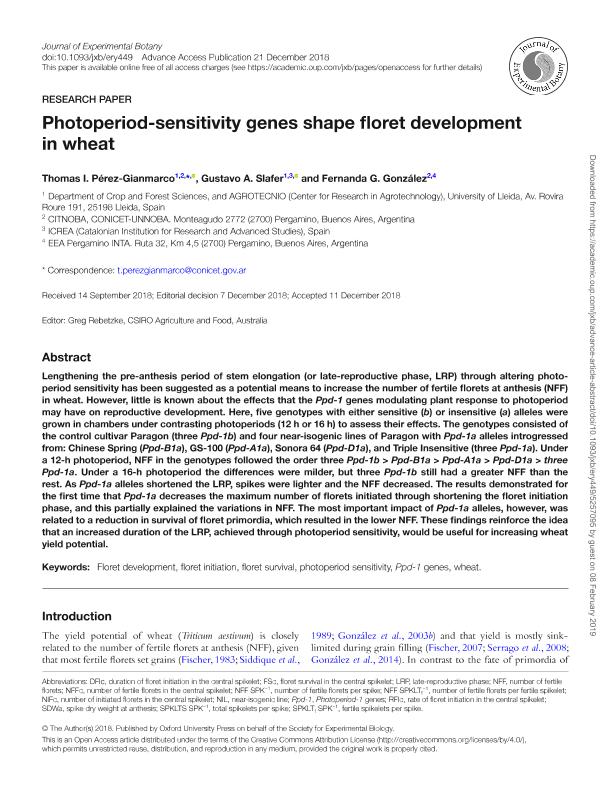Artículo
Photoperiod-sensitivity genes shape floret development in wheat
Fecha de publicación:
02/2019
Editorial:
Oxford University Press
Revista:
Journal of Experimental Botany
ISSN:
0022-0957
Idioma:
Inglés
Tipo de recurso:
Artículo publicado
Clasificación temática:
Resumen
Lengthening the pre-anthesis period of stem elongation (or late-reproductive phase, LRP) through altering photoperiod sensitivity has been suggested as a potential means to increase the number of fertile florets at anthesis (NFF) in wheat. However, little is known about the effects that the Ppd-1 genes modulating plant response to photoperiod may have on reproductive development. Here, five genotypes with either sensitive (b) or insensitive (a) alleles were grown in chambers under contrasting photoperiods (12 h or 16 h) to assess their effects. The genotypes consisted of the control cultivar Paragon (three Ppd-1b) and four near-isogenic lines of Paragon with Ppd-1a alleles introgressed from: Chinese Spring (Ppd-B1a), GS-100 (Ppd-A1a), Sonora 64 (Ppd-D1a), and Triple Insensitive (three Ppd-1a). Under a 12-h photoperiod, NFF in the genotypes followed the order three Ppd-1b > Ppd-B1a > Ppd-A1a > Ppd-D1a > three Ppd-1a. Under a 16-h photoperiod the differences were milder, but three Ppd-1b still had a greater NFF than the rest. As Ppd-1a alleles shortened the LRP, spikes were lighter and the NFF decreased. The results demonstrated for the first time that Ppd-1a decreases the maximum number of florets initiated through shortening the floret initiation phase, and this partially explained the variations in NFF. The most important impact of Ppd-1a alleles, however, was related to a reduction in survival of floret primordia, which resulted in the lower NFF. These findings reinforce the idea that an increased duration of the LRP, achieved through photoperiod sensitivity, would be useful for increasing wheat yield potential.
Archivos asociados
Licencia
Identificadores
Colecciones
Articulos(SEDE CENTRAL)
Articulos de SEDE CENTRAL
Articulos de SEDE CENTRAL
Citación
Pérez Gianmarco, Thomas Ignacio; Slafer, Gustavo Ariel; González, Fernanda Gabriela; Photoperiod-sensitivity genes shape floret development in wheat; Oxford University Press; Journal of Experimental Botany; 70; 4; 2-2019; 1339-1348
Compartir
Altmétricas




